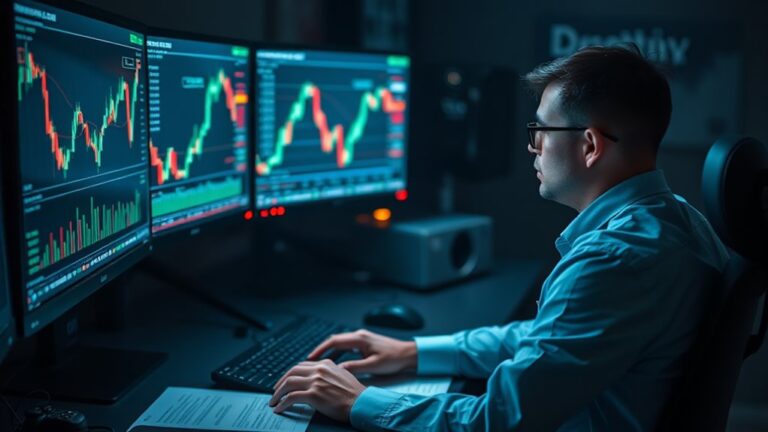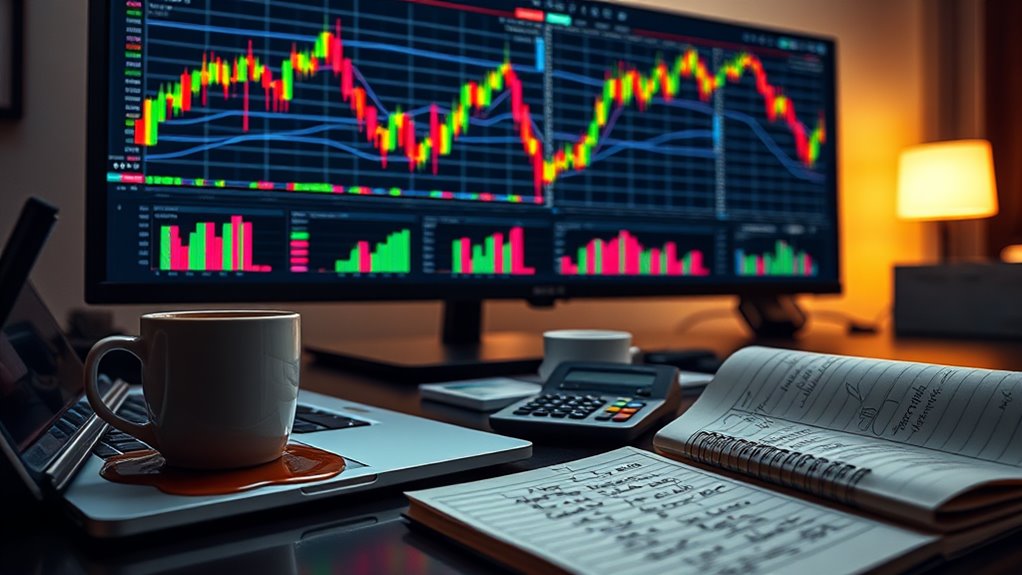
Margin Trading: A Beginner’s Guide to Crypto Leverage
Margin trading in cryptocurrency involves leveraging borrowed funds to potentially amplify profits, though it also increases the risk of substantial losses. Traders can use high leverage ratios, like 100:1, to capitalize on both rising and falling markets. It’s vital to choose a reputable platform, assess one’s risk tolerance, and employ risk management techniques like stop-loss orders. Understanding market trends and choosing the right leverage are imperative. More insights can be uncovered by exploring further strategies and best practices.
Key Takeaways
- Margin trading in crypto uses borrowed funds to increase potential gains and losses.
- Beginners should start with lower leverage to minimize risk.
- Utilize stop-loss orders to manage potential losses effectively.
- Choose reputable exchanges with strong security measures and intuitive interfaces.
- Understand and comply with legal requirements and tax implications of margin trading.
Understanding the Basics of Crypto Margin Trading
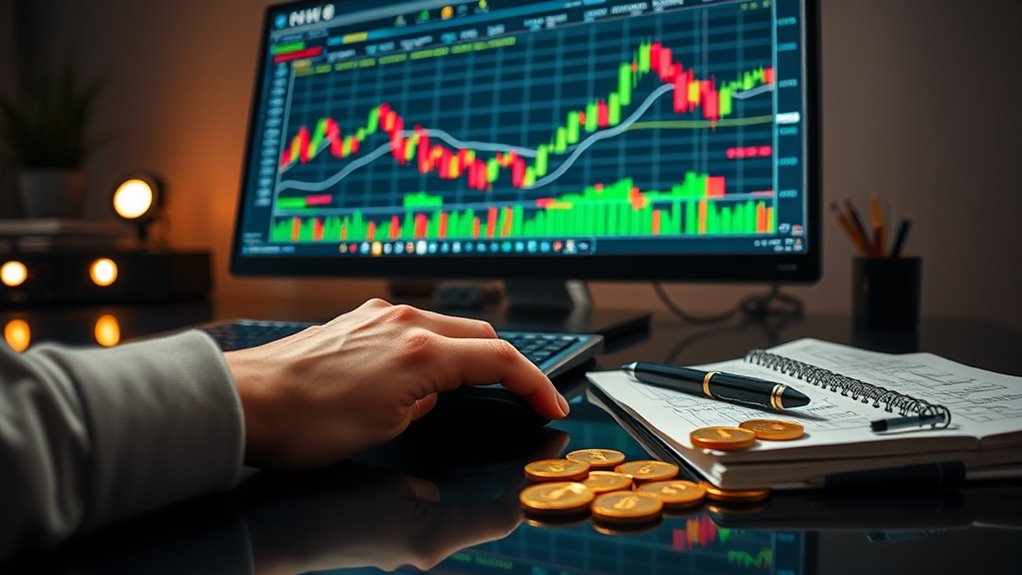
As a strategic tool used by traders, crypto margin trading involves borrowing funds to enhance potential profits on investments, but it also requires careful consideration due to the increased risk of substantial losses.
This form of trading, known as leveraged trading, allows individuals to amplify their trading exposure, which means bigger potential returns but also increased potential risks. Leveraged ratios can be as high as 100:1, permitting traders to take on large positions with relatively small amounts of collateral.
Crypto margin trading offers the flexibility to capitalize on both rising and falling markets by taking long or short positions.
However, due to the volatility of the cryptocurrency market, even small price movements can result in significant losses or even total liquidation of the position. It is crucial to integrate risk management strategies to minimize the potential for devastating losses, as highlighted in comprehensive guides on leverage usage.
Setting Up Your First Margin Account

When setting up your first margin account, the initial step involves selecting a cryptocurrency exchange that offers robust security and appropriate leverage options.
It’s vital to choose a reputable exchange, as this determines the safety of your funds and the effectiveness of your trading. Following selection, registration typically requires identity verification and setting up two-factor authentication to enhance security.
Prospective traders must then fund their accounts, which can be done via bank transfer, credit card, or transferring cryptocurrencies.
Additionally, it’s important to fully understand the risks associated with margin trading and become acquainted with the exchange’s trading interface to guarantee efficient management of trades.
For newcomers, considering exchanges that provide educational resources can significantly ease the learning curve associated with understanding both the platform and the broader cryptocurrency trading environment.
How to Choose the Right Leverage for You
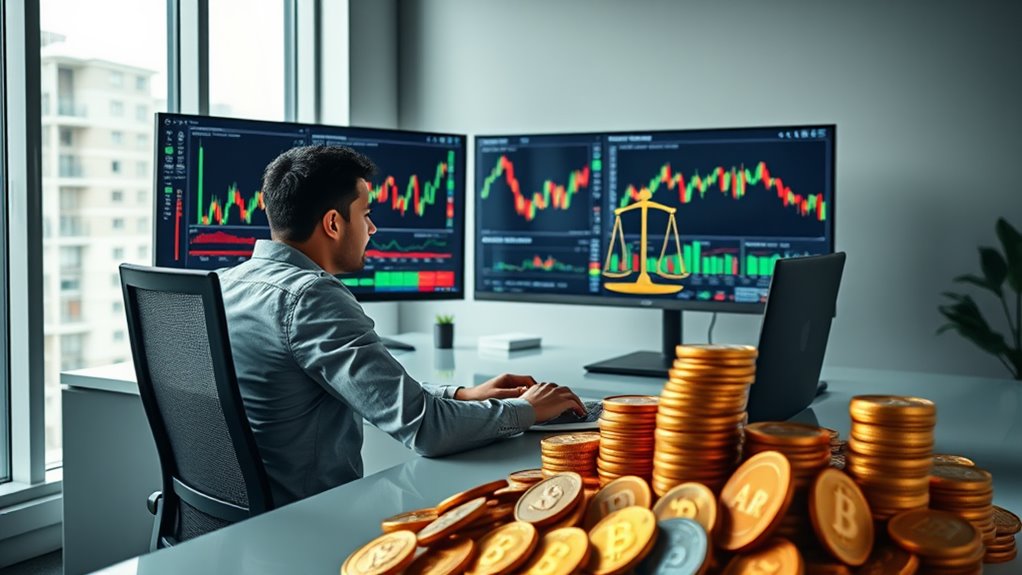
Choosing the right leverage in cryptocurrency margin trading involves careful consideration of one’s risk tolerance, the volatility of the market, and financial goals. Individuals must evaluate how much risk they can endure, as higher leverage can lead to significant gains or losses, depending particularly on market fluctuations. Aligning leverage with one’s long-term financial objectives and trading strategy is essential to manage potential risks and maximize returns effectively. It’s also crucial to implement risk management strategies such as setting stop-loss orders to protect against unforeseen market movements.
Assessing Risk Tolerance
Understanding one’s risk tolerance is essential in determining the appropriate leverage for cryptocurrency margin trading. Before choosing the level of leverage, one must thoroughly evaluate their financial situation to decide how much risk they can responsibly afford.
Emotional discipline is important since the heightened stress of potential amplified losses in volatile markets requires level-headed decision-making. For beginners, starting with lower leverage is advisable to minimize risks while gaining necessary market experience.
Implementing risk management strategies, such as diversification and using stop-loss orders, also plays a significant role. Additionally, informed decisions based on current and thorough market knowledge help in optimizing leverage use without compromising capital preservation.
Furthermore, a prevalent error many traders make is neglecting market research, which could be detrimental when using leveraged positions, as it hampers the ability to respond effectively to market conditions.
Market Volatility Considerations
After evaluating one’s risk tolerance in margin trading, understanding market volatility becomes essential in selecting the appropriate leverage level.
Market volatility, characterized by rapid and significant price swings, directly affects the impact of leverage on one’s trading position. With higher leverage, such as 100x, even minimal market fluctuations can result in substantial changes to one’s trading account, potentially leading to margin calls or liquidation.
As a result, it is advisable for traders, especially novices, to opt for lower leverage ratios. This conservative approach helps manage risk and buffers against the unpredictable dynamics of the crypto market.
Using informed strategies and maintaining emotional control are vital for steering through the complexities introduced by high leverage in volatile trading environments.
Additionally, utilizing tools like chart patterns and technical indicators can provide deeper insights into market trends and help in managing the risks associated with high leverage.
Financial Goals Alignment
Selecting the right level of leverage in margin trading involves aligning financial strategies with individual or organizational goals effectively. This alignment is essential to optimize outcomes while managing inherent risks.
The variability in margin requirements, trading strategies, and risk tolerance levels both color and complicate this decision process, making it a pivotal focus for both novice and experienced traders.
- Risk Tolerance Assessment: Choosing leverage based on individual comfort with potential losses, reconciling desire for high returns with the capability to withstand market fluctuations.
- Strategic Timeframe: Adapting leverage choices to match the intended duration of investments, differentiating between long-term stability and short-term gains.
- Regular Review and Adjustment: Monitoring trading outcomes and adjusting leverage ratios to align with shifting goals and market conditions, ensuring sustained relevance and risk management.
A crucial step in mastering margin trading is the understanding of market dynamics, which plays a significant role in making informed leverage decisions.
Strategies for Long and Short Positions
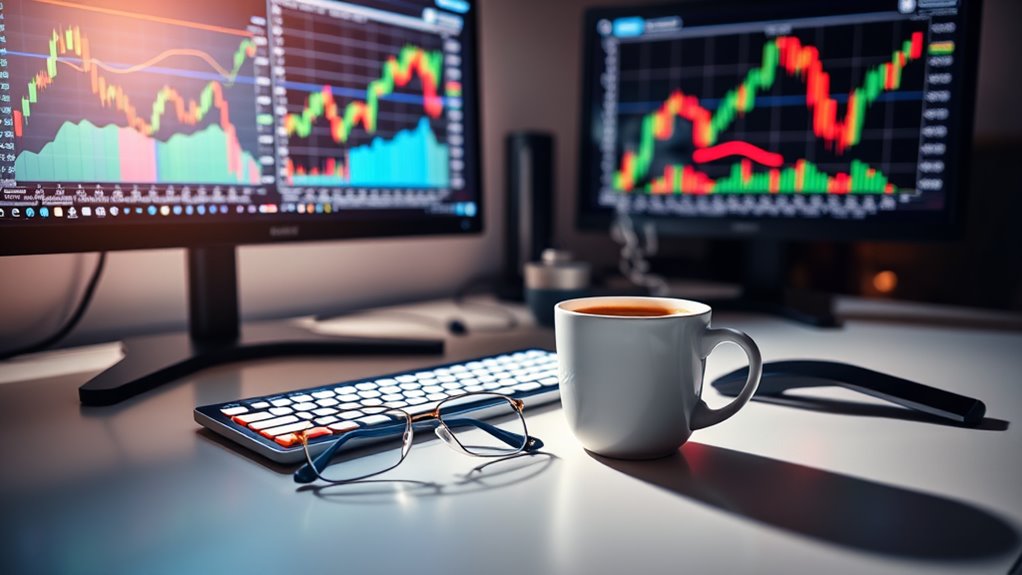
How can traders effectively manage both long and short positions in margin trading?
In long positions, traders employ leverage to buy more cryptocurrency than they can afford on their own, aiming to profit from expected price increases. It’s vital to select a reliable exchange and perform thorough market analysis before committing.
Alternatively, short positions involve borrowing cryptocurrency to sell, anticipating a decline in price to repurchase it cheaper and pocket the difference. This strategy benefits from using stop-loss orders to curb losses in unpredictable markets.
Both strategies require understanding market trends and technical analysis. Implementing tools like stop-losses and monitoring market conditions are essential in managing the risks associated with both long and short positions in margin trading.
The Role of Maintenance Margin in Trading

While strategies for managing long and short positions provide foundation for engaging in margin trading, equally important is the understanding of maintenance margin. This key component helps manage risk by requiring a minimum amount of equity to keep trades open and prevent forced liquidations.
Exploring maintenance margin is crucial in managing risks and preventing unwanted trading liquidations in margin trading.
Here are several vital aspects:
- Risk Management Tool: It serves as a critical safeguard to avoid significant losses that could deplete a trader’s capital.
- Margin Call Trigger: Falling below the maintenance margin can trigger a margin call, requiring the trader to add funds or close positions to restore the required level.
- Variable Requirements: Different exchanges and assets may dictate different maintenance margin levels, reflecting the volatility and risk associated with those assets.
Choosing the right trading strategy, such as spot trading versus futures trading, greatly depends on understanding these variables and their impact on maintenance margins, which in turn affects overall risk exposure and potential returns.
Interest Rates and Cost Considerations

Understanding the influence of interest rates and associated costs is essential when engaging in margin trading. Interest is calculated hourly, applying even if the principal is borrowed for less than an hour. These rates can fluctuate considerably depending on market conditions, exchange policies, and the Federal Funds Rate.
Cryptocurrencies’ high volatility can cause rates to spike, affecting the cost markedly. Additionally, exchanges may impose trading and liquidation fees, further impacting profitability.
Effectively managing these costs involves strategies such as executing short-term trades to minimize interest accumulation, selecting assets with lower rates, and vigilantly monitoring market conditions.
Comparing rates across different platforms guarantees that traders choose the most cost-effective options, adapting strategies as market environments and platform policies evolve.
Utilizing Stop-Loss and Take-Profit Orders Effectively

Effective management of stop-loss and take-profit orders can greatly enhance a trader’s ability to navigate the fluctuating landscapes of cryptocurrency markets. By strategically setting these orders, traders can protect capital and lock in profits without needing to monitor positions continually.
Maximize trading efficiency in crypto markets with strategic stop-loss and take-profit orders.
- Order Types: Utilize limit orders for precision or market orders for speed depending on your strategy.
- Risk Tolerance and Market Analysis: Adjust stop-loss and take-profit levels in response to your risk tolerance and real-time market analysis to optimize outcomes.
- Dynamic Adjustments: Implement trailing stop-loss orders to protect gains as prices increase, and adapt take-profit points to reflect changes in market sentiment or new analytical data, ensuring profit goals align with ongoing market conditions.
Risk Management Techniques in Margin Trading

As traders engage in margin trading, employing effective stop-loss strategies is essential for capital preservation during unexpected market downturns.
Choosing a balanced level of leverage is equally important, as it helps maintain manageable loss margins and enhances potential gains without overly increasing risk exposure.
These techniques, when properly implemented, are fundamental to maneuvering the complexities of crypto leverage and safeguarding investments.
Effective Stop-Loss Strategies
To minimize losses in the precarious environment of margin trading, investors often rely on effective stop-loss strategies. This risk mitigation tool is essential as it limits potential losses by automatically executing a sale if the asset price drops below a predefined level.
Here are a few strategic methods:
- Support and Resistance: Placing stop-loss orders just below the support level for long positions or above the resistance level for short positions.
- Moving Averages: Utilizing moving averages as dynamic thresholds to adjust stop placements in response to market changes.
- Average True Range (ATR): Setting the stop-loss distance based on the ATR, which helps accommodate the asset’s volatility, potentially preventing premature trade exits.
Balanced Leverage Selection
When selecting the appropriate leverage for margin trading, traders must carefully balance potential returns against the risks of increased exposure.
Leverage ratios, which dictate how much borrowed funds a trader can control relative to their own capital, vary widely, from conservative 2x to aggressive 10x and beyond.
Cautious, less experienced traders might opt for lower leverage ratios like 2x or 3x, minimizing potential losses. Conversely, more seasoned traders may select higher leverages such as 10x, aiming for significant gains while accepting the heightened risk of substantial losses.
Adjusting leverage based on market volatility, personal financial goals, and the complexity of trading strategies is critical in fostering a prudent, yet potentially profitable trading approach.
A new sentence with analyzing market trends related to the efficient use of technical indicators is essential for optimizing leverage decisions and breakout trading success.
Choosing the Best Platform for Margin Trading

Why is selecting the ideal platform for margin trading essential for both novice and experienced traders?
Choosing the right platform enhances security, increases potential profitability, and provides necessary tools for effective risk management.
Selecting the right platform can significantly boost security, profit potential, and provide crucial risk management tools.
Each platform varies considerably in the following key aspects:
- Security and Reliability: Look for platforms like Kraken, which offer strong security measures and are established with a reputable history.
- Fees and Leverage Options: Consider platforms like Binance and Bybit, which offer competitive fees and high leverage options, vital for maximizing trading flexibility and profit potential.
- User Experience: Prioritize platforms that provide intuitive interfaces, robust customer support, and educational resources, making trading more accessible and manageable.
Understanding different types of exchanges can greatly influence your choice, as it impacts the features available and the regulatory environment of the platform.
Tax Implications and Legal Frameworks

Understanding the tax obligations and legal requirements is essential for anyone engaged in crypto margin trading.
In the U.S., gains from such trading are subject to capital gains taxes, and detailed record-keeping is vital for legal compliance.
Additionally, evolving legal frameworks across different jurisdictions may impact how traders manage their activities and report their taxes.
Navigating Tax Obligations
Maneuvering the tax obligations associated with margin trading in cryptocurrencies is vital, as several taxable events can trigger financial responsibilities for traders.
Understanding these events and their implications can help in preparing accurate tax returns and potentially reducing tax liabilities.
- Taxable Events: Engaging in trades, sales, or liquidations results in recognized capital gains or losses, which must be declared using specific IRS forms.
- Interest Deductibility: The interest paid on margin loans might be deductible, although its applicability to crypto trading remains a grey area and requires careful assessment.
- Record Keeping: Meticulously documenting all transactions and fees is essential for compliance and calculating the adjusted cost basis needed for tax reporting.
Legal Requirements Overview
The legal landscape for margin trading in cryptocurrencies involves various regulatory bodies and frameworks that govern how these activities are conducted, especially with regards to tax implications and legal jurisdictions.
In the U.S., agencies such as the Commodity Futures Trading Commission (CFTC) and the National Futures Association (NFA) oversee these trading types, mandating that operations occur on regulated exchanges. These platforms, including Kraken and Coinbase Pro, adhere to specific leverage limits and margin requirements.
Additionally, laws vary considerably across states and countries, complicating compliance. For instance, while the U.K. has imposed bans on crypto derivatives for retail consumers, the U.S. presents a mosaic of state-dependent regulations, affecting everything from market access to the liquidity of cryptographic assets.
Frequently Asked Questions
Can I Switch Between Leverage Ratios During an Open Trade?
The person can switch between leverage ratios during an open trade if the platform supports this feature. However, it’s important to understand the associated risks and technical limitations that might affect the trade.
How Are Different Cryptocurrencies Valued for Margin Trading?
Cryptocurrencies are valued like volatile treasures in margin trading, considering factors such as market liquidity, global demand, and regulatory environments. Trading volume and platform-specific conditions also greatly influence their valuation for leveraged trades.
What Happens if My Margin Trade Is Liquidated?
If a margin trade is liquidated, the exchange forcibly closes the position. This action is taken to cover losses by selling the collateral. Traders risk losing more than their initial investment and incurring additional fees.
Are There Advantages to Margin Trading in Bear Markets?
Is seeking profit in a falling market possible? Margin trading in bear markets offers increased purchasing power, short selling options, diverse strategies, and potential for high returns, albeit with increased risks and potential for greater losses.
How Does Geopolitical Instability Affect Crypto Margin Trading?
Geopolitical instability heightens market volatility, impacting crypto margin trading by amplifying risks and potential gains. Sudden price swings may trigger margin calls, demanding adept risk management and strategy adjustments from traders.
Conclusion
In summary, maneuvering through the complexities of crypto margin trading requires a solid understanding, meticulous risk management, and strategic planning. By establishing a margin account, selecting suitable leverage, and executing calculated long and short trades, investors can potentially enhance their returns. However, maintaining vigilant oversight over maintenance margin, utilizing stop-loss and take-profit orders, and understanding tax and legal implications are essential steps in safeguarding one’s investment while aiming for success in the volatile world of cryptocurrency trading.







